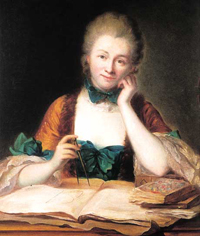Redressing the balance 5 : Emilie du Châtelet
 Voltaire famously wrote that Emilie du Châtelet was “a great man whose only fault was being a woman” – I suspect that this was meant as a compliment although it doesn’t really come across that way today! In this blog we’ll look at her life and achievements.
Voltaire famously wrote that Emilie du Châtelet was “a great man whose only fault was being a woman” – I suspect that this was meant as a compliment although it doesn’t really come across that way today! In this blog we’ll look at her life and achievements.
Emilie du Châtelet was born in Paris like Sophie Germain, only 70 years earlier in 1706. She was home-educated in maths, literature and science by tutors employed by her father. It is widely believed that Emilie’s mother was so against her only daughter receiving such an education that she tried to have her sent to a convent.
When she was eighteen years old Emilie married the Marquis du Châtelet who allowed her to continue her studies. Even with three children and a full social life in the court she did not give up mathematics. Her philosophy was to “study hard and play hard”. Having said that sometimes her two worlds collided – she used her understanding of probability to help her when gambling with varying degrees of success. Later in life when her debts were catching up with her, she designed a complicated scheme for repayment similar to modern derivatives.
Emilie’s greatest achievement was probably her translation of Newton’s Principia into French along with her own commentary which she completed shortly before her death following childbirth in 1749. In addition to this she published important work on kinetic energy. Emilie du Châtelet was one of the first people to come up with a formula showing energy as proportional to the square of velocity (this was later developed to be ½mv² which should be familiar to anyone studying A level Maths with Mechanics or Physics). Her non-mathematical writings such as “Discourse on Happiness” are still quoted from today.
Emilie du Châtelet helped to shape the future of mathematics in Europe. In a world where the education of women was seen as undesirable this was an amazing achievement.